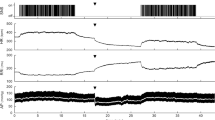Abstract
Background
Regadenoson is a coronary vasodilator that causes tachycardia via activation of the sympathetic nervous system. We determined whether β1-adrenergic blockade can attenuate tachycardia without significantly reducing coronary vasodilation induced by regadenoson.
Methods and Results
Hemodynamics and coronary blood flow (CBF) were measured in conscious dogs. Baseline CBF and heart rate (HR) were 42 ± 2 mL/min and 87 ± 8 bpm (mean ± SEM), respectively. Regadenoson (1, 2.5, and 5 μg/kg) increased peak CBF by 129 ± 10, 149 ± 7, and 174 ± 10 mL/min and HR by 48 ± 6, 67 ± 5, and 85 ± 11 bpm, respectively, (all P < .05 vs baseline). In the presence of metoprolol (1.5 mg/kg), the peak increases in CBF caused by these three doses of regadenoson were reduced by only 11 ± 7%, 10 ± 4%, and 21 ± 2% (P = NS, <.05, and <.05 vs regadenoson alone), respectively, whereas the regadenoson-induced tachycardia was significantly reduced by 55 ± 8%, 55 ± 4%, and 52 ± 5% (all P < .05). In the presence of metoprolol, the duration of the regadenoson-induced increase in CBF was reduced, but the duration of the 2-fold increase in CBF caused by 5 μg/kg regadenoson was still nearly 6 minutes.
Conclusion
β1-Adrenergic blockade with metoprolol attenuated the regadenoson-induced increase in HR more than the increase in CBF.








Similar content being viewed by others
References
Iskandrian AE, Bateman TM, Belardinelli L, Blackburn B, Cerqueira MD, Hendel RC, et al. Adenosine versus regadenoson comparative evaluation in myocardial perfusion imaging: Results of ADVANCE phase 3 multicenter international trial. J Nucl Cardiol 2007;14:645-58.
Jaroudi WA, Iskandrian AE. Regadenoson: A new myocardial stress agent. J Am Coll Cardiol 2009;54:1123-30.
Tejani FH, Thompson RC, Iskandrian AE, McNutt BE, Franks B. Effects of caffeine on SPECT myocardial perfusion imaging during regadenoson pharmacologic stress: Rationale and design of a prospective, randomized, multicenter study. J Nucl Cardiol 2011;18:73-81.
Cerqueira MD. The future of pharmacologic stress: Selective A2A adenosine receptor. Am J Cardiol 2004;94:33D-42D.
Hendel RC, Bateman TM, Cerqueira MD, Iskandrian AE, Leppo JA, Blackburn B, et al. Initial clinical experience with regadenoson, a novel selective A2A agonist for pharmacologic stress single-photon emission computed tomography myocardial perfusion imaging. J Am Coll Cardiol 2005;46:2069-75.
Lieu H, Shryock JC, von-Mering GO, Gordi T, Blackburn B, Olmsted AW, et al. Regadenoson, a selective A2A adenosine receptor agonist, causes dose-dependent increases in coronary blood flow velocity in humans. J Nucl Cardiol 2007;14:514-20.
Trochu JN, Zhao G, Post H, Xu X, Belardinelli L, Belloni F, et al. Selective A2A adenosine receptor agonist as a coronary vasodilator in conscious dogs: Potential for use in myocardial perfusion imaging. J Cardiovasc Pharmacol 2003;41:132-9.
Zhao G, Linke A, Xu X, Ochoa M, Belloni F, Belardinelli L, et al. Comparative profile of vasodilation by CVT-3146, a novel A2A receptor agonist, and adenosine in conscious dogs. J Pharmacol Exp Ther 2003;307:182-9.
Zhao G, Messina E, Xu X, Ochoa M, Sun HL, Leung K, et al. Caffeine attenuates the duration of coronary vasodilation and changes in hemodynamics induced by regadenoson (CVT-3146), a novel adenosine A2A receptor agonist. J Cardiovasc Pharmacol 2007;49:369-75.
Biaggioni I, Killian TJ, Mosqueda-Garcia R, Robertson RM, Robertson D. Adenosine increases sympathetic nerve traffic in humans. Circulation 1991;83:1668-75.
Dhalla AK, Wong MY, Wang WQ, Biaggioni I, Belardinelli L. Tachycardia caused by A2A adenosine receptor agonists is mediated by direct sympathoexcitation in awake rats. J Pharmacol Exp Ther 2006;316:695-702.
Zhao G, Serpillon S, Shryock J, Messina E, Xu X, Ochoa M, et al. Regadenoson, a novel pharmacologic stress agent for use in myocardial perfusion imaging, does not have a direct effect on the QT-interval in conscious dogs. J Cardiovasc Pharmacol 2008;52:467-73.
Mekkaoui C, Jadbabale F, Dione DP, Meoli DF, Purushothaman K, Belardinelli L, et al. Effects of adenosine and a selective A2A adenosine receptor agonist on hemodynamic and thallium-201 and technetium-99m-sestaMIBI biodistribution and kinetics. J Am Coll Cardiol Cardiovasc Imaging 2009;2:1198-208.
Kerins DM, Robertson RM, Robertson D. Drugs used for the treatment of myocardial ischemia. In: Hardman JG, Limbird LE, Gilman AG, editors. Goodman & Gilman’s the pharmacological basis of therapeutics 10th ed. New York, NY: McGraw-Hill; 2001. p. 843-70.
Vatner SF, Hintze TH, Macho P. Regulation of large coronary arteries by β-adrenergic mechanisms in the conscious dog. Circ Res 1982;51:56-66.
Vatner SF, Hintze TH. Mechanism of constriction of large coronary arteries by β-adrenergic receptor blockade. Circ Res 1983;53:389-400.
Gao Z, Li Z, Baker SP, Lasley RD, Mayer S, Elzein E, et al. Novel short-acting A2A adenosine receptor agonists for coronary vasodilation: Inverse relationship between affinity and duration of action of A2A agonists. J Pharmacol Exp Ther 2001;298:209-18.
Author information
Authors and Affiliations
Corresponding author
Additional information
Supported by Gilead Sciences and by NIH PO-1-43023, RO-1-HL50142, and HL 61290 (to T. H. Hintze).
Rights and permissions
About this article
Cite this article
Zhao, G., Zhang, S., Shryock, J.C. et al. Selective action of metoprolol to attenuate regadenoson-induced tachycardia in conscious dogs. J. Nucl. Cardiol. 19, 109–117 (2012). https://doi.org/10.1007/s12350-011-9481-x
Received:
Accepted:
Published:
Issue Date:
DOI: https://doi.org/10.1007/s12350-011-9481-x




